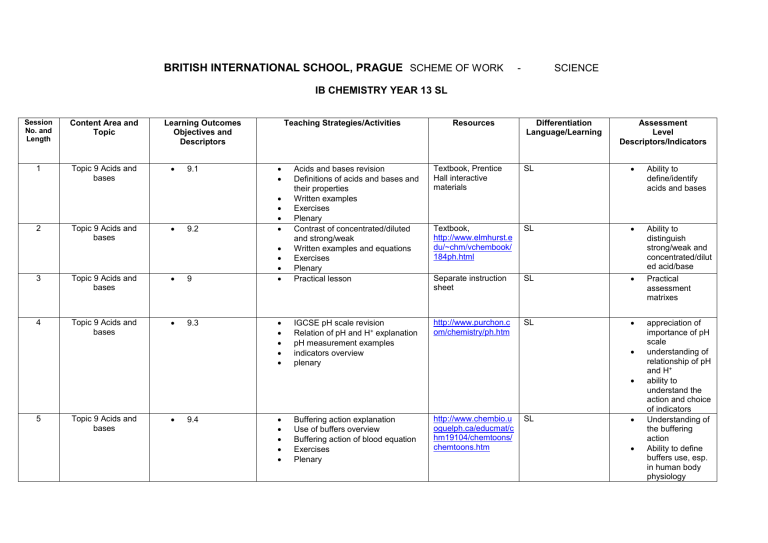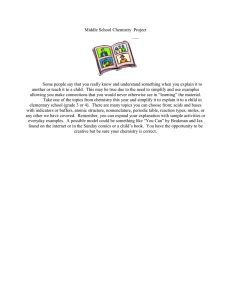
BRITISH INTERNATIONAL SCHOOL, PRAGUE SCHEME OF WORK - SCIENCE IB CHEMISTRY YEAR 13 SL Session No. and Length Content Area and Topic 1 Topic 9 Acids and bases 2 Topic 9 Acids and bases Learning Outcomes Objectives and Descriptors 9.1 Teaching Strategies/Activities 9.2 Acids and bases revision Definitions of acids and bases and their properties Written examples Exercises Plenary Contrast of concentrated/diluted and strong/weak Written examples and equations Exercises Plenary Practical lesson IGCSE pH scale revision Relation of pH and H+ explanation pH measurement examples indicators overview plenary 3 Topic 9 Acids and bases 9 4 Topic 9 Acids and bases 9.3 Resources Differentiation Language/Learning Assessment Level Descriptors/Indicators Textbook, Prentice Hall interactive materials SL Ability to define/identify acids and bases Textbook, http://www.elmhurst.e du/~chm/vchembook/ 184ph.html SL Separate instruction sheet SL Ability to distinguish strong/weak and concentrated/dilut ed acid/base Practical assessment matrixes http://www.purchon.c om/chemistry/ph.htm SL 5 Topic 9 Acids and bases 9.4 Buffering action explanation Use of buffers overview Buffering action of blood equation Exercises Plenary http://www.chembio.u oguelph.ca/educmat/c hm19104/chemtoons/ chemtoons.htm SL appreciation of importance of pH scale understanding of relationship of pH and H+ ability to understand the action and choice of indicators Understanding of the buffering action Ability to define buffers use, esp. in human body physiology Session No. and Length Content Area and Topic 6 Topic 9 Acids and bases 9 Practical lesson Separate instruction sheet SL Practical assessment matrixes 7 Topic 9 Acids and bases 9.5 Acid-base titrations IGCSE review Titration curves of weak/strong acid/base reactions Suitability of indicators assumption Exercises Plenary End of chapter test http://www.wwnorton. com/chemistry/tutorial s/ch16.htm SL IB past papers compiled questions copies SL Understanding of a titration curve Ability to choose an appropriate indicator and predict its action IB percentage boundaries Principles of oxidation and reduction review Oxidation number, bonding powers, oxidizing/reducing agents Exercises Plenary Redox equations Balancing using numbers of electrons exchanged Exercises Plenary practical lesson Textbook SL Data booklet SL Separate instruction sheet SL Reactivity series revision Oxidative/reducing properties Ions of common metals and their reactivity Predictions of reactions with diluted acids Plenary Data booklet SL Learning Outcomes Objectives and Descriptors Teaching Strategies/Activities 8 Topic 9 Acids and bases 9 9 Topic 10 Oxidation and reduction 10.1 10 Topic 10 Oxidation and reduction 10.1 11 Topic 10 Oxidation and reduction 10 12 Topic 10 Oxidation and reduction 10.2 Resources Differentiation Language/Learning Assessment Level Descriptors/Indicators Understanding of the inner charge of atoms in molecules and their bonding powers Ability to balance redox equations using the number of exchanged electrons practical assessment matrixes Ability to state the reactivity series Ability to infer the properties of elements from the series Session No. and Length Content Area and Topic 13 Topic 10 Oxidation and reduction Learning Outcomes Objectives and Descriptors 10.2 Teaching Strategies/Activities Resources Internet resources Redox reaction exercises Voltaic cell structure and function drawing Circuit completion and electric current Exercises Differentiation Language/Learning SL Assessment Level Descriptors/Indicators 14 Topic 10 Oxidation and reduction 10 practical lesson Separate instruction sheet SL 15 Topic 10 Oxidation and reduction 10.2, 10.3 Apparatus scheme, electrodes SL Electrode potentials of metals Electrolysis of a molten salt apparatus and principle Electrodes suitable for electrolysis Exercises Plenary 16 Topic 10 Oxidation and reduction 10.3 Practical use of electrolysis Half-reactions on electrodes Exercises Plenary Apparatus schemes, textbook SL 17 Topic 10 Oxidation and reduction 10.3 practical lesson Separate instruction sheet SL 18 Topic 10 Oxidation and reduction 10 end of chapter test chapter conclusion IB past papers questions compiled SL Understanding of the principle of a Daniell cell Ability to draw/collect apparatus and predict its function practical assessment level matrixes Understanding of the fact different metals possess different electrode potentials Appreciation of importance of electrolysis in metals production and the beauty of the process Appreciation of aluminium production and electrolysis of sodium chloride (quick reference to electrolysis of solution) practical assessment matrixes IB percentage boundaries Session No. and Length Content Area and Topic 19 Topic 11 Organic chemistry Learning Outcomes Objectives and Descriptors 11.1 Teaching Strategies/Activities SL Appreciation hydrocarbons exist in different homologous groups according their bonds and structures Separate instruction sheet SL practical assessment matrixes Structural formulae and names of alkanes drawing Combustion of alkanes equations Plenary textbook SL Prentice Hall molecular models Reactions of alkenes with other compounds Uses of reactions of alkenes in industry Plenary Understanding of alkanes’ formulae and ability to interpret them Appreciation of importance of combustion of alkanes for industrial purposes Understanding of reaction mechanisms of reactions of hydrocarbons Appreciation of the importance of alkenes reactions for industry practical assessment matrixes Topic 11 Organic chemistry 11 21 Topic 11 Organic chemistry 11.2 11.2 Assessment Level Descriptors/Indicators http://www.wwnorton. com/chemistry/tutorial s/ch16.htm 20 Topic 11 Organic chemistry Differentiation Language/Learning Homologous series revision Trends of boiling points within the series prediction Isomerism Functional groups properties determination Plenary practical lesson 22 Resources SL 23 Topic 11 Organic chemistry 11 practical lesson Separate instruction sheet SL 24 Topic 11 Organic chemistry 11.3 Condensation reaction of alcohols and acids outline Partial and complete oxidation of ethanol reactions Plenary http://www.wwnorton. com/chemistry/tutorial s/ch16.htm SL Appreciation esters have variety of uses in everyday life Ability to interpret equations of alcohols Session No. and Length Content Area and Topic Learning Outcomes Objectives and Descriptors Teaching Strategies/Activities Resources Differentiation Language/Learning Assessment Level Descriptors/Indicators oxidation for chemical industry 25 Topic 11 Organic chemistry 11.3 http://www.wwnorton. com/chemistry/tutorial s/ch16.htm dehydration reaction of alcohols to produce alkenes Oxidation of primary, secondary and tertiary alcohols Plenary SL 26 Topic 11 Organic chemistry 11 practical lesson Separate instruction sheet SL 27 Topic 11 Organic chemistry 11.3 Polymerisation of alkenes outline Addition polymerization Plenary Prentice Hall molecular models SL 28 29 Topic 11 Organic chemistry Topic 11 Organic chemistry 11.3 11 Prentice Hall molecular models Condensation polymerization of amines and carboxylic acids Formation of peptides and proteins Plenary practical lesson Separate instruction sheet SL SL Appreciation alcohols have variety of uses in everyday life Ability to interpret equations of alcohols oxidation for chemical industry practical assessment matrixes Ability to model the polymerization reactions Understanding of processes taking place in polymers formation Ability to model the polymerization reactions Understanding of processes taking place in polymers formation practical assessment matrixes Session No. and Length Content Area and Topic 30 Topic 11 Organic chemistry 11 end of chapter test Test copies SL IB percentage boundaries 31 Optional topics A - H A-H Optional topics according to standard level Chemistry curriculum To be specified SL To be specified 32 Optional topics A - H A-H Optional topics according to standard level Chemistry curriculum To be specified SL To be specified 33 Optional topics A - H A-H Optional topics according to standard level Chemistry curriculum To be specified SL To be specified 34 Optional topics A - H A-H Optional topics according to standard level Chemistry curriculum To be specified SL To be specified 35 Optional topics A - H A-H Optional topics according to standard level Chemistry curriculum To be specified SL To be specified 36 Optional topics A - H A-H Optional topics according to standard level Chemistry curriculum To be specified SL To be specified 37 Optional topics A - H A-H Optional topics according to standard level Chemistry curriculum To be specified SL To be specified 38 Optional topics A - H A-H Optional topics according to standard level Chemistry curriculum To be specified SL To be specified Learning Outcomes Objectives and Descriptors Teaching Strategies/Activities Resources Differentiation Language/Learning Assessment Level Descriptors/Indicators Session No. and Length Content Area and Topic 39 Optional topics A - H A-H Optional topics according to standard level Chemistry curriculum To be specified SL To be specified 40 Optional topics A - H A-H Optional topics according to standard level Chemistry curriculum To be specified SL To be specified 41 Optional topics A - H A-H Optional topics according to standard level Chemistry curriculum To be specified SL To be specified 42 Optional topics A - H A-H Optional topics according to standard level Chemistry curriculum To be specified SL To be specified 43 Optional topics A - H A-H Optional topics according to standard level Chemistry curriculum To be specified SL To be specified 44 Optional topics A - H A-H Optional topics according to standard level Chemistry curriculum To be specified SL To be specified 45 Optional topics A - H A-H End of chapter test Test copies SL IB percentage boundaries 46 1 – 13 A-H 1 – 13 A–H Revision lesson Past papers SL IB percentage boundaries 47 1 – 13 A-H 1 – 13 A–H Revision lesson Past papers SL IB percentage boundaries Learning Outcomes Objectives and Descriptors Teaching Strategies/Activities Resources Differentiation Language/Learning Assessment Level Descriptors/Indicators Session No. and Length Content Area and Topic Learning Outcomes Objectives and Descriptors 48 1 – 13 A-H 1 – 13 A–H Revision lesson Past papers SL IB percentage boundaries 49 1 – 13 A-H 1 – 13 A–H Revision lesson Past papers SL IB percentage boundaries 50 1 – 13 A-H 1 – 13 A–H Revision lesson Past papers SL IB percentage boundaries 51 1 – 13 A-H 1 – 13 A–H Revision lesson Past papers SL IB percentage boundaries 52 1 – 13 A-H 1 – 13 A–H Revision lesson Past papers SL IB percentage boundaries 53 1 – 13 A-H 1 – 13 A–H Revision lesson Past papers SL IB percentage boundaries 54 1 – 13 A-H 1 – 13 A–H Revision lesson Past papers SL IB percentage boundaries 55 1 – 13 A-H 1 – 13 A–H Revision lesson Past papers SL IB percentage boundaries 56 1 – 13 A-H 1 – 13 A–H Revision lesson Past papers SL IB percentage boundaries Teaching Strategies/Activities Resources Differentiation Language/Learning Assessment Level Descriptors/Indicators Session No. and Length Content Area and Topic Learning Outcomes Objectives and Descriptors 57 1 – 13 A-H 1 – 13 A–H Revision lesson Past papers SL IB percentage boundaries 58 1 – 13 A-H 1 – 13 A–H Revision lesson Past papers SL IB percentage boundaries 59 1 – 13 A-H 1 – 13 A–H Revision lesson Past papers SL IB percentage boundaries 60 1 – 13 A-H 1 – 13 A–H Revision lesson Past papers SL IB percentage boundaries 61 1 – 13 A-H 1 – 13 A–H Revision lesson Past papers SL IB percentage boundaries 62 1 – 13 A-H 1 – 13 A–H Revision lesson Past papers SL IB percentage boundaries Teaching Strategies/Activities Resources Differentiation Language/Learning Assessment Level Descriptors/Indicators



